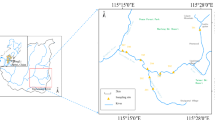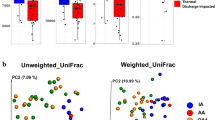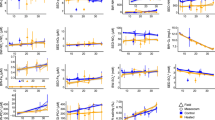Abstract
We examine how heterotrophic bacterioplankton communities respond to temperature by mathematically defining two thermally adapted species and showing how changes in environmental temperature affect competitive outcome in a two-resource environment. We did this by adding temperature dependence to both the respiration and uptake terms of a two species, two-resource model rooted in Droop kinetics. We used published literature values and results of our own work with experimental microcosms to parameterize the model and to quantitatively and qualitatively define relationships between temperature and bacterioplankton physiology. Using a graphical resource competition framework, we show how physiological adaptation to temperature can allow organisms to be more, or less, competitive for limiting resources across a thermal gradient (2–34 °C). Our results suggest that the effect of temperature on bacterial community composition, and therefore bacterially mediated biogeochemical processes, depends on the available resource pool in a given system. In addition, our results suggest that the often unclear relationship between temperature and bacterial metabolism, as reported in the literature, can be understood by allowing for changes in the relative contribution of thermally adapted populations to community metabolism.
Similar content being viewed by others
Log in or create a free account to read this content
Gain free access to this article, as well as selected content from this journal and more on nature.com
or
References
Azam F, Fenchel T, Field JG, Gray JS, Meyer-Reil LA, Thingstad TF . (1983). The ecological role of water-column microbes in the sea. Mar Ecol Prog Ser 10: 257–263.
Button DK . (1998). Nutrient uptake by microorganisms according to kinetic parameters from theory as related to cytoarchitecture. Microbiol Mol Biol Rev 62: 636–645.
Cho BC, Azam F . (1988). Major role of bacteria in biogeochemical fluxes in the ocean's interior. Nature 332: 441–443.
Cole JJ, Pace ML, Caracao NF, Steinhart GS . (1993). Bacterial biomass and cell size distributions in lakes: more and larger cells in anoxic waters. Limnol Oceanogr 38: 1627–1632.
Cotner JB, Makino W, Biddanda BA . (2006). Temperature affects stoichiometry and biochemical composition of Escherichia coli. Microb Ecol 52: 26–33.
Cotner JB, Wetzel RG . (1992). Uptake of dissolved inorganic and organic phosphorus compounds by phytoplankton and bacterioplankton. Limnol Oceanogr 37: 232–243.
Crump BC, Hobbie JE . (2005). Synchrony and seasonality in bacterioplankton communities of two temperate rivers. Limnol Oceanogr 50: 1718–1729.
del Giorgio PA, Cole JJ . (2000). Bacterial energetics and growth efficiency. In: Kirchman DL (ed). Microbial Ecology of the Oceans. Wiley-Liss: New York. p 542.
Ellis-Evans JC, Wynn-Williams DD . (1985). The interaction of soil and lake microflora at Signy Island. In: Siegfried WR, Condy PR, Laws RM (eds). Antarctic Nutrient Cycles. Springer Verlag: Berlin. pp 662–668.
Elser JJ, Chrzanowski TH, Sterner RW, Schampel JH, Foster DK . (1995). Elemental ratios and the uptake and release of nutrients by phytoplankton and bacteria in three lakes of the Canadian Shield. Microb Ecol 29: 145–162.
Fagerbakke KM, Heldal M, Norland S . (1996). Content of carbon, nitrogen, oxygen, sulfur and phosphorus in native aquatic and cultured bacteria. Aquatic Microb Ecol 10: 15–27.
Fuhrman JA, Azam F . (1983). Adaptations of bacteria to marine subsurface waters studied by temperature response. Mar Ecol Prog Ser 13: 95–98.
Fuhrman JA, Hewson I, Schwalbach MS, Steele JA, Brown MV, Naeem S . (2006). Annually reoccurring bacterial communities are predictable from ocean conditions. Proc Natl Acad Sci USA 103: 13104–13109.
Hall EK . (2006). Interacting effects of temperature and nutrients on the metabolism and biomass composition of natural bacterioplankton communities. PhD thesis, University of Minnesota.
Hall EK, Cotner JB . (2007). Interactive effect of temperature and resources on carbon cycling by freshwater bacterioplankton communities. Aquatic Microb Ecol 49: 35–45.
Kato K . (1985). Seasonal observations of heterotrophic activity and active bacterial number in Lake Constance. Arch Hydrobiol Suppl 66: 309–319.
Mansilla MC, Cybulski LE, Albanesi D, Mendoza DD . (2004). Control of membrane lipid fluidity by molecular thermosensors. J Bacteriol 186: 6681–6688.
Mechling JA, Kilham SS . (1983). Temperature effects on silicon limited growth of the Lake Michigan diatom Stephanodiscus minutus (Bacillariophyceae). J Phycol 18: 119–205.
Nedwell DB . (1999). Effect of low temperature on microbial growth: lowered affinity for substrates limits growth at low temperature. FEMS Microbiol Ecol 30: 101–111.
Nichols DS, Nichols PD, McMeekin TA . (1993). Polyunsaturated fatty acids in Antarctic bacteria. Antarctic Sci 5: 149–160.
Nishimura Y, Kim C, Nagata T . (2005). Vertical and seasonal variations of bacterioplankton subgroups with different nuclei acid contents: possible regulation by phosphorus. Appl Environ Microbiol 71: 5828–5836.
Pinhassi J, Hagstrom A . (2000). Seasonal succession in marine bacterioplankton. Aquatic Microb Ecol 21: 245–256.
Pomeroy LR, Wiebe WJ . (2001). Temperature and substrates as interactive limiting factors for marine heterotrophic bacteria. Aquatic Microb Ecol 23: 187–204.
Pommier T, Pinhassi J, Hagstrom A . (2005). Biogeographic analysis of ribosomal RNA clusters from marine bacterioplankton. Aquatic Microb Ecol 41: 79–89.
Rivkin RB, Anderson MR, Lajzerowicz C . (1996). Microbial processes in cold oceans. I. Relationship between temperature and bacterial growth rate. Aquatic Microb Ecol 10: 243–254.
Robarts RD, Sephton LM, Wicks RJ . (1991). Labile dissolved organic carbon and water temperature as regulators of heterotrophic bacterial activity and production in the lakes of Sub-Antarctic Marion Island. Polar Biol 11: 403–413.
Russell NJ, Fukunaga N . (1990). A comparison of thermal adaptation of membrane lipids in psychrophilic and thermophilic bacteria. FEMS Microbiol Rev 75: 171–182.
Shade A, Kent AD, Jones SE, Newton RJ, Triplett EW, McMahon KD . (2007). Interannual dynamics and phenology of bacterial communities in a eutrophic lake. Limnol Oceanogr 52: 487–494.
Simon M, Glockner FO, Amann R . (1999). Different community structure and temperature optima of heterotrophic picoplantkon in various regions of the Southern Ocean. Aquatic Microb Ecol 18: 275–284.
Thingstad TF . (1987). Utilization of N, P, and organic C by heterotrophic bacteria. I. Outline of a chemostat theory with a consistent concept of ‘maintenance’ metabolism. Mar Ecol Prog Ser 35: 99–109.
Tilman D . (1980). Resources: a graphical-mechanistic approach to competition and predation. Am Nat 116: 363–393.
Tilman D, Mattson M, Langer S . (1981). Competition and nutrient kinetics along a temperature gradient: an experimental test of a mechanistic approach to niche theory. Limnol Oceanogr 26: 1020–1033.
Venter JC et al. (2004). Environmental genome shotgun sequencing of the Sargasso Sea. Science 304: 66–74.
Villar-Argaiz M, Medina-Sanchez JM, Carrillo P . (2002). Microbial plankton response to contrasting climatic conditions: insights from community structure, productivity and fraction stoichiometry. Aquatic Microb Ecol 29: 253–266.
Wetzel RG . (2001). Limnology: Lake and River Ecosystems. Academic Press: San Diego, CA.
Yannarell AC, Kent AD, Lauster GH, Kratz TK, Triplett EW . (2003). Temporal patterns in bacterial communities in three temperate lakes of different trophic status. Microb Ecol 46: 391–405.
Acknowledgements
EKH would like to acknowledge Alma Hall for her support during the preparation of the manuscript. In addition, the quality of the manuscript was greatly improved by comments from three anonymous reviewers and discussions with the Litchman-Klausmeier lab group, including several specific comments from K Yoshiyama.
Author information
Authors and Affiliations
Corresponding author
Rights and permissions
About this article
Cite this article
Hall, E., Neuhauser, C. & Cotner, J. Toward a mechanistic understanding of how natural bacterial communities respond to changes in temperature in aquatic ecosystems. ISME J 2, 471–481 (2008). https://doi.org/10.1038/ismej.2008.9
Received:
Accepted:
Published:
Issue date:
DOI: https://doi.org/10.1038/ismej.2008.9
Keywords
This article is cited by
-
The impacts of climate change on coastal groundwater
Nature Reviews Earth & Environment (2024)
-
Influence of water temperature and water depth on macrophyte–bacterioplankton interaction in a groundwater-fed river
Environmental Science and Pollution Research (2020)
-
UPLC-MS/MS analysis of antibiotics in pharmaceutical effluent in Tunisia: ecotoxicological impact and multi-resistant bacteria dissemination
Archives of Microbiology (2018)
-
Important interaction of chemicals, microbial biomass and dissolved substrates in the diel hysteresis loop of soil heterotrophic respiration
Plant and Soil (2018)
-
Warming and nutrient enrichment in combination increase stochasticity and beta diversity of bacterioplankton assemblages across freshwater mesocosms
The ISME Journal (2017)



